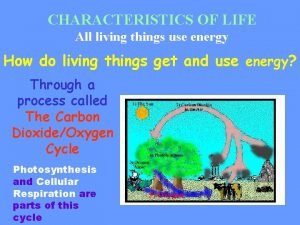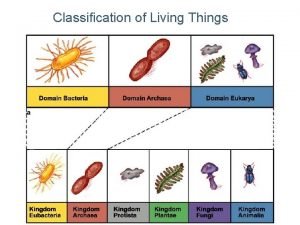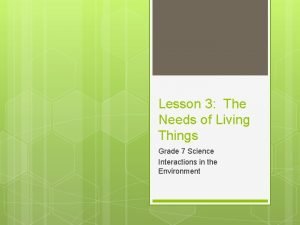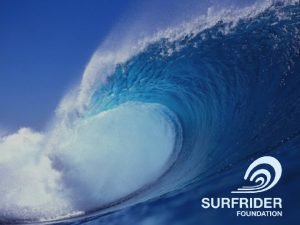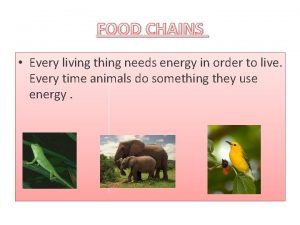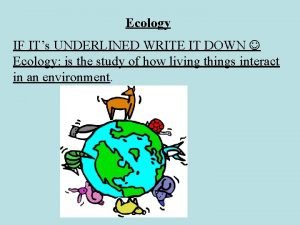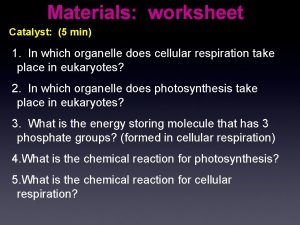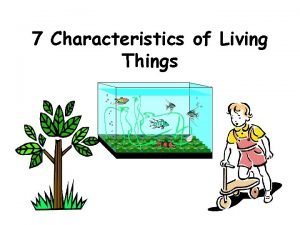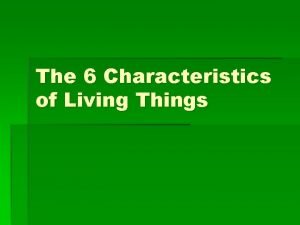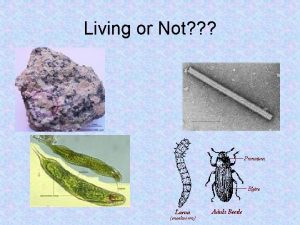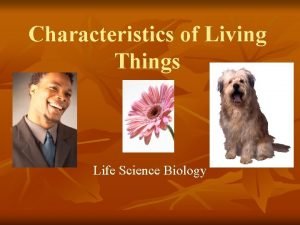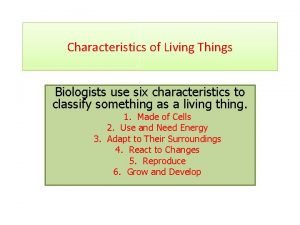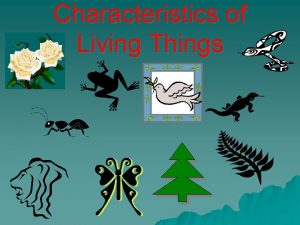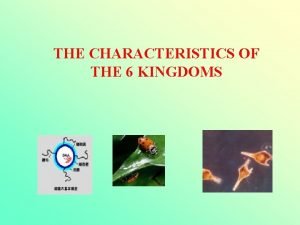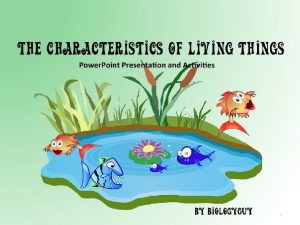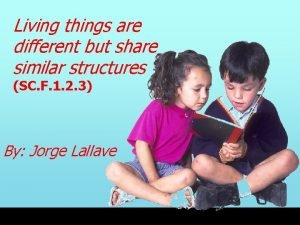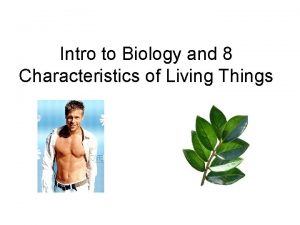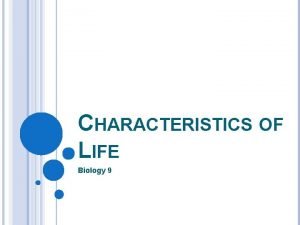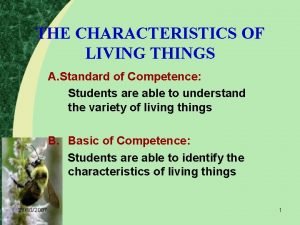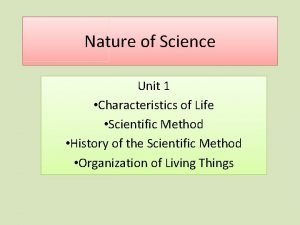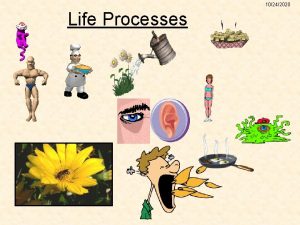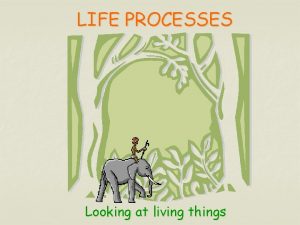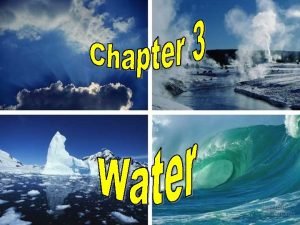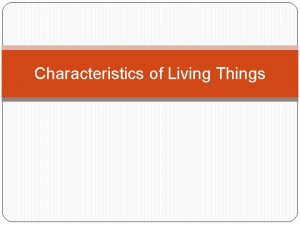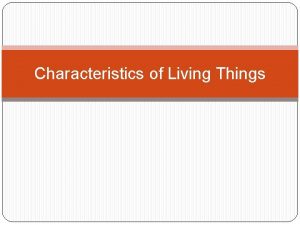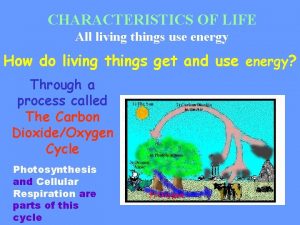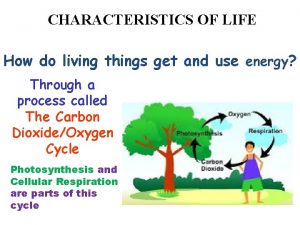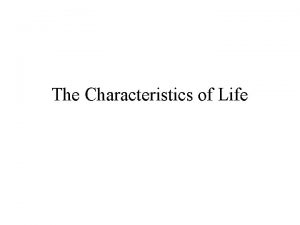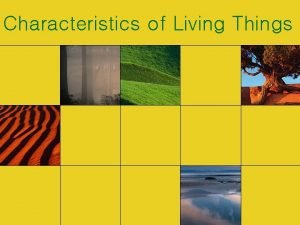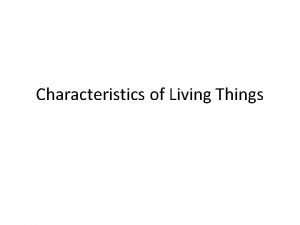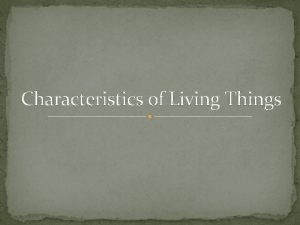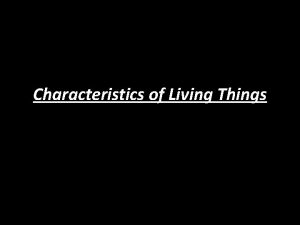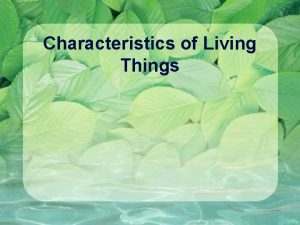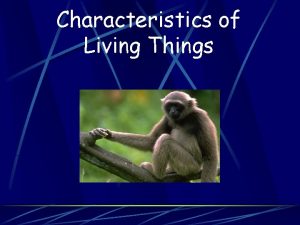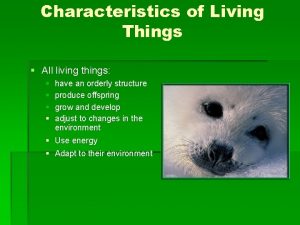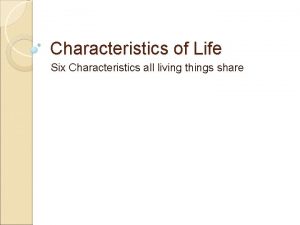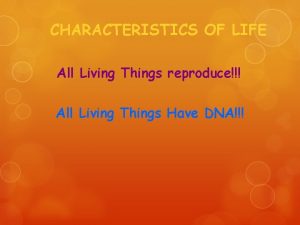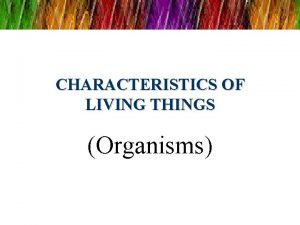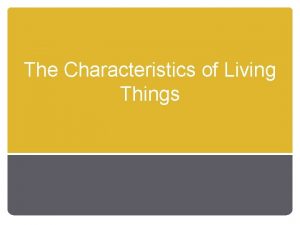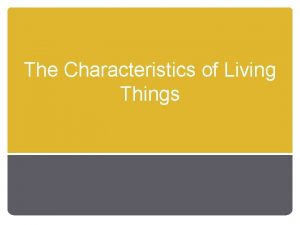CHARACTERISTICS OF LIFE All living things use energy






































- Slides: 38

CHARACTERISTICS OF LIFE All living things use energy How do living things get and use energy? Through a process called The Carbon Dioxide/Oxygen Cycle Photosynthesis and Cellular Respiration are parts of this cycle

What organisms go through photosynthesis? • Producers/autotrophs, – such as plants, trees, algae, some bacteria

PHOTOSYNTHESIS Definition: THE PROCESS BY WHICH GREEN PLANTS USE LIGHT, WATER AND CARBON DIOXIDE TO MAKE GLUCOSE (food) AND MAKE THE SUN’S ENERGY AVAILABLE TO ALL LIVING THINGS.

HOW DO THE MATERIALS FOR PHOTOSYNTHESIS ENTER THE PLANT? ? ? Carbon Dioxide – enters the plant through a pore called a STOMATA. Water – enters the plant through the roots and is carried up the stem by the XYLEM. Water leaves the plant through the STOMATA.

WHERE DOES PHOTOSYNTHESIS TAKE PLACE? ? ? IN THE LEAVES, SPECIFICALLY IN THE CHLOROPLASTS!!!!

Where does photosynthesis take place? • In the chloroplasts of plant cells found in the leaves! Plant Cell Chloroplast

Stroma (fluid) Parts of a Chloroplast Thylakoid (single sac) Granum Outer Membrane Inner Membrane

Chloroplasts have chlorophyll • Chlorophyll is a green pigment that reacts to sunlight by transferring energy to e- (electrons) • Makes chloroplasts and plants look green • Reflect green light waves from the sun

Role of Pigments are light-absorbing colored molecules. n Different pigments absorb different wavelengths of light. Chlorophylls are the major light-absorbing pigments in plants. n They absorb energy from violet-blue light and reflect green light, giving plants their green color. n

Accessory Pigments n Role of Accessory Pigments: n Accessory pigments help plants absorb additional light. Plants need to make these accessory pigments to maximize the amount of photosynthesis they can do. n More pigments = More glucose or food for the plant!

Types of Accessory Pigments Carotenoids: reflect yellow, orange, and red light. n Carotenoids give carrots and sweet potatoes their orange color and are very common in our area. n Anthocyans: reflect red, blue, violet light. n Xanthophylls: reflect yellow light. n

Accessory Pigments n Accessory pigments are the reason leaves change colors in autumn. In green leaves, there is so much chlorophyll that it masks the other pigments. n In autumn, as trees prepare to lose their leaves, the chlorophyll molecules break down, revealing the colors of other pigments. The colors red, yellow, and orange can be seen.

CO 2 H 2 O SUGAR PRODUCED IS CALLED GLUCOSE C 6 H 1206 O 2 IS A WASTE PRODUCT

What exactly IS photosynthesis? ? ? Photosynthesis • A CHEMICAL REACTION!!!!!!! • SO, PLANTS CHANGE WATER, CO 2, AND SUNLIGHT INTO NEW SUBSTANCES!!!

If you were making a cake, what would the… • Reactants be? • Product be? flour eggs sugar water etc a cake!

Photosynthesis Equation: Sunlight + 6 CO 2 + 6 H 2 O carbon dioxide water C 6 H 12 O 6 + sugar (glucose) 6 O 2 oxygen

The chemical reaction looks like this: carbon dioxide + water + sunlight glucose + oxygen 6 CO 2 + 6 H 2 O + Energy C 6 H 12 O 6 + 6 O 2 Remember, THE BONDS that hold GLUCOSE together CONTAIN THE ENERGY FROM THE SUN AND ARE STORED FOR LATER USE BY THE PLANT. . .

Photosynthesis Chemical Equation: Sunlight + 6 CO 2 + 6 H 2 O carbon dioxide water = C 6 H 12 O 6 + 6 O 2 sugar (glucose) oxygen Reactants Products “what is used” “what is made”

Stroma (fluid) Parts of a Chloroplast Thylakoid (single sac) Granum Outer Membrane Inner Membrane

Photosynthesis Light-Dependent Reaction - Occurs in thylakoid membrane Light-Independent Reaction AKA Calvin Cycle - Occurs in stroma - sunlight is required - sunlight is NOT required - O 2 is produced from water -Glucose is produced from CO 2

Photosynthesis Chemical Equation: Sunlight + 6 CO 2 + 6 H 2 O carbon dioxide water = C 6 H 12 O 6 + 6 O 2 sugar (glucose) oxygen Reactants Products “what is used” “what is made”

Photosynthesis: This is the chemical reaction on Earth which allows the amount of carbon dioxide in the atmosphere to remain constant. • Photosynthesis removes 60 million tons of carbon dioxide from the air each year. • It occurs in all green plants on the surface of the Earth and also in the algae (seaweed) and in plankton (unicellular organisms) living near the surface of bodies of water (such as the ocean).

• Finally, photosynthesis is the only way our planet can regenerate oxygen gas (O 2) for respiration of living things. Without oxygen to breathe, aerobic life would not exist. • Oxygen is the product of photosynthesis. Without oxygen, all animal and human life (including oxygen loving decomposing bacteria) would die. • Oxygen is used by living things to break down food so that energy can be released. Without oxygen gas, nothing would be able to burn.

CHARACTERISTICS OF LIFE All living things use energy How do living things get and use energy? Through a process called The Carbon Dioxide/Oxygen Cycle Photosynthesis and Cellular Respiration are parts of this cycle

• How do CONSUMERS obtain their energy? ? ? • By a process called CELLULAR RESPIRATION… DEFINITION: Cellular Respiration is the process used by living cells to break down sugar molecules (glucose) that living things obtain when they consume. ATP Energy is then released from the glucose during this process.

CELLULAR RESPIRATION Glucose and Oxygen goes to the mitochondria of a cell. Energy is released from food in the mitochondria. Oxygen is the key that unlocks the energy.

HOW DOES GLUCOSE GET INTO YOUR CELLS • Food containing glucose goes to your stomach and small intestines where food is digested. • The glucose is absorbed through the walls of the small intestines. • The blood carries the glucose to your cells for cellular respiration to occur. • At the same time, oxygen is breathed in the lungs, picked up by the red blood cells and transported to every cell in the body.

Where does it take place? ? ? • IN EVERY SINGLE CELL, SPECIFICALLY IN THE MITOCHONDRIA!!!

C 6 H 1206 O 2 H 2 0 ENERGY RELEASED CO 2 Water and carbon dioxide are waste products

What exactly IS respiration? ? ? • A CHEMICAL REACTION!!! • ALL organisms change glucose and oxygen to useable energy called ATP-energy, CO 2, and Water…

This chemical reaction involves oxygen and results in the production of ATP energy, carbon dioxide and water: C 6 H 12 O 6 + 6 O 2 6 CO 2 + 6 H 2 O + ATP Energy glucose oxygen carbon water energy dioxide




So, the reactions for photosynthesis and respiration are OPPOSITES of one another. The products of one are the reactants for the other. The equations look like this: carbon dioxide + water + sunlight glucose + oxygen 6 CO 2 + 6 H 2 O + Energy C 6 H 12 O 6 + 6 O 2 reactants products glucose + oxygen carbon dioxide + water + ATP energy C 6 H 12 O 6 + 6 O 2 6 CO 2 + 6 H 2 O + ATP Energy reactants products

Counting Atoms in Photosynthesis

Counting Atoms in Cellular Respiration

1. Name this cycle in nature. 2. What two processes are going on in this picture?
 What is the smallest living unit of life
What is the smallest living unit of life 7 life processes
7 life processes Life cycle of all living things
Life cycle of all living things Venn diagram of living and nonliving things
Venn diagram of living and nonliving things Living things use carbohydrates for
Living things use carbohydrates for Why do we classify living things
Why do we classify living things Tissue are grouped together to form various
Tissue are grouped together to form various What are the 5 basic needs of all living things
What are the 5 basic needs of all living things Are all living things based on the metric system
Are all living things based on the metric system Throwaway living
Throwaway living How many links are there in a food chain
How many links are there in a food chain What are the producers in a food web
What are the producers in a food web Gets its energy from eating living things
Gets its energy from eating living things How living things obtain energy worksheet answers
How living things obtain energy worksheet answers How do heterotrophs and autotrophs differ
How do heterotrophs and autotrophs differ 7 characteristics of living things
7 characteristics of living things 6 characteristics of living things
6 characteristics of living things Movement characteristics of living things
Movement characteristics of living things Six characteristics of living things
Six characteristics of living things The six characteristics of life
The six characteristics of life Two characteristics of living things
Two characteristics of living things Characteristics of life
Characteristics of life Characteristics of animal kingdom
Characteristics of animal kingdom Mrs gren activity
Mrs gren activity Characteristics of animals as living things
Characteristics of animals as living things 8 characteristics of living things
8 characteristics of living things Characteristics of living things ppt
Characteristics of living things ppt 9 characteristics of life
9 characteristics of life What is characteristic of living things
What is characteristic of living things Characteristics of living things
Characteristics of living things 7 characteristics of living things
7 characteristics of living things How does plant move
How does plant move The seven life processes of living things
The seven life processes of living things Name a point that is collinear with the given points
Name a point that is collinear with the given points Is moss living or non-living
Is moss living or non-living Living non living dead
Living non living dead Energy energy transfer and general energy analysis
Energy energy transfer and general energy analysis Energy energy transfer and general energy analysis
Energy energy transfer and general energy analysis Why is water important to living things
Why is water important to living things


